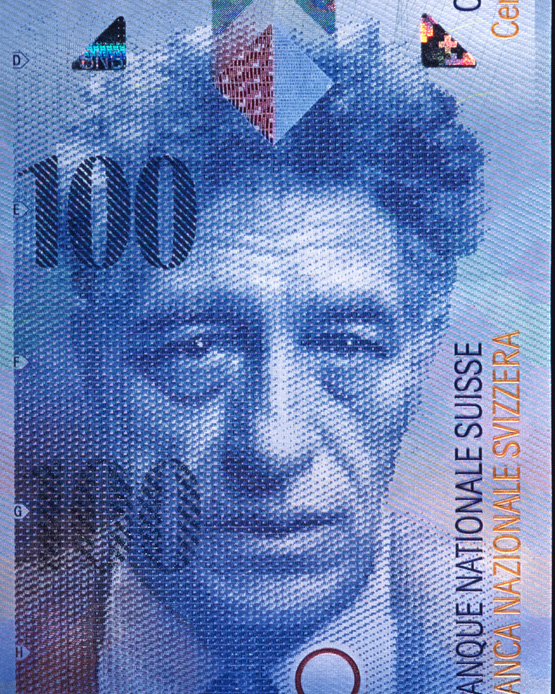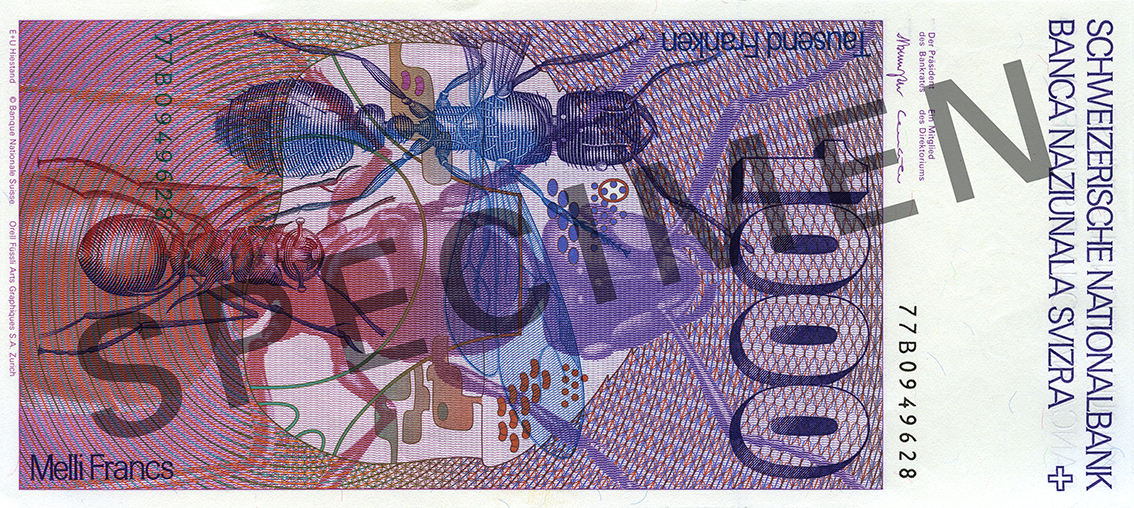The CHF1,000 dance of death and other unforgettable Swiss banknotes

The Swiss National Bank (SNB) puts a lot of thought into the design and production of its banknotes. Some recent denominations, however, have crossed the invisible line into the public imagination.
The SNB recently launched a competition to design the tenth series of banknotes, which will replace the one currently in circulation. “Switzerland, variety in relief” is the theme to which designers wishing to participate must adhere.
“The future series is to be dedicated to the unique topography of the Swiss territory, from the Jura to the Plateau to the Alps, and to depict the entire country, from the deepest valleys to the highest peaks. The banknotes should reproduce the diversity of life along the Swiss reliefs,” explained Martin Schlegel, chairman of the SNB governing board, on October 30.
Creating banknotes that are not only functional but also beautiful is important for every central bank. For the federalist Switzerland of the late 19th and early 20th century, however, it was also a question of national unity.
“The cantons were hesitant to grant powers to the central government, and this also applied to banknotes,” explains Patrick Halbeisen, director of the archives of the Swiss National Bank (SNB). “Not least because they received taxes on the issue of banknotes.”
Before 1906, there were 36 so-called issuing banks. From that year, however, the power to issue banknotes was the prerogative of the newly founded SNB. “For the population, however, a central bank was something very abstract. I think it was important for this new institution, the SNB, to give a strong image,” Halbeisen says.
The SNB therefore commissioned two of the best-known artists of the time, Eugène Burnand and Ferdinand Hodler, to design the banknotes. The result was the second series of banknotes, the longest-lived (the first, known as the interim series, was printed on the model of those of the previous note-issuing banks with the addition of the rosette and the federal cross on the overprinting). The banknotes signed by Burnand and Hodler were issued between 1911 and 1914 and were not replaced until 1956/57.
The announcement might seem a little premature. After all, the most recent denomination of the current series, the CHF100 note, has only been in circulation since 2019, the year in which hands collecting water supplanted Alberto Giacometti’s face. Not before time, some might say, given the bags under the Graubünden artist’s eyes.

But everything is on schedule, according to the SNB. The competition with the theme of “Switzerland open to the world” – the basis for the current ninth series – was launched in 2005, and the first banknote didn’t enter circulation until 11 years later.
There’s no denying it, the current banknotes are beautiful. This is not just a personal opinion, even the International Bank Note Society (IBNS) has praised them, selecting the CHF50 and CHF10 as “best banknote of the year” in 2016External link and in 2017External link respectively.
However – and this is a personal opinion – the current series lacks the character that made some of the past series so emblematic, perhaps because cash is being used less and less or perhaps because this series is still too recent. The fact is that I’ve heard people talk about “three Giacometti” when referring to CHF300, but I’ve never heard anyone say “It cost me three Bisse d’Ayent” (a marvel of Alpine hydraulic engineering in the Valais, depicted on the CHF100).

Alongside Giacometti, the architect Le Corbusier on the CHF10 banknote and artist Sophie Taeuber-Arp on the CHF50 banknote can be mentioned in the same series (the eighth) to cross that invisible boundary into the collective imagination. For people less well versed in 20th-century abstract art, Taeuber-Arp is perhaps less well known than Giacometti and Le Corbusier, but she remains the only woman depicted on a Swiss banknote.
Animal charm
Taking a step back, the undisputed stars of the sixth series (the seventh was a reserve series that never entered circulation) are the mathematician Leonhard Euler on the CH10 and the baroque-era architect Francesco Borromini on the CHF100.
This is if one considers human beings, because the sixth series is most remembered for animals: the owl on the reverse of the CHF50 and, of course, ants on the CHF1,000. The VIP represented on the highest value banknote was the psychiatrist, neurologist and myrmecologist Auguste Forel, famous for his studies of the brain structures of humans and, indeed, ants.
The average Swiss citizen is not familiar with Forel’s work, but the banknote on which he is depicted is perhaps the most emblematic one ever printed in Switzerland.


Saying “a Formicone” to refer to the CHF1,000 note soon became a habit, to the extent that the nickname for this denomination remained even once the sixth series was replaced.
Memento mori
Let’s take one last leap back in time to talk about what is perhaps one of the most disturbing banknotes ever printed: the fifth series CHF1,000 (first issued in 1956/57).

It must be said that this denomination, although it represents 57% of the value of all banknotes in circulation today, is not often seen. The CHF1,000 – currently worth about $1,125 – is the most valuable banknote one can hold (the $10,000 Singapore and Brunei notes, worth about CHF6,500, are no longer produced). So, when you do get your hands on one, you can’t help but feel a sense of opulence and fantasise about how nice it would be to own a few more.
One has the impression that the artist Pierre Gauchat, who conceived the image, and the SNB, which decided to put it on the fifth series CHF1,000, wanted to bring those who let their imaginations run wild in this way back to Earth. The banknote in fact depicts the “danse macabre”, the dance of death, a medieval iconographic theme in which people (men, women, children, popes or sovereigns) dance with skeletons.
It’s obviously an allegory of death and the ephemerality of life. “You think you are rich and powerful with me in your hands?” the note seems to want to say. “Well, remember that you have to die”. Definitely a suggestive effect, but I still prefer the Formicone.

More
How a Swiss banknote’s life comes to an end
Translated from Italian by DeepL/ts
More

In compliance with the JTI standards
More: SWI swissinfo.ch certified by the Journalism Trust Initiative













You can find an overview of ongoing debates with our journalists here . Please join us!
If you want to start a conversation about a topic raised in this article or want to report factual errors, email us at english@swissinfo.ch.